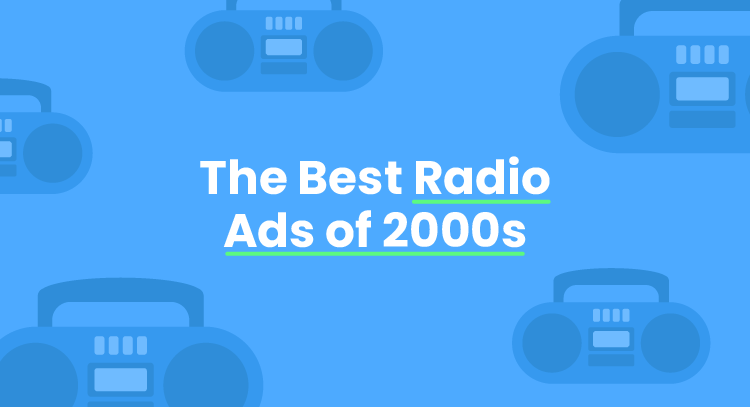The 2000s was an era that witnessed significant advancements in technology, shaping the way we consume media.
While television and the internet gained prominence, traditional mediums like radio continued to hold a special place in people’s hearts.
In this article
- The Power of Audio
- Localized Appeal
- Personalities and Endorsements
- Engaging Imagery
- Contest Craze
- Commercials as Entertainment
- Soundtracks of Nostalgia
- “Silence the Beat” (Apple iPod)
- “The Man Your Man Could Smell Like” (Old Spice)
- “Give Me Back That Filet-O-Fish” (McDonald’s)
- “The Happiness Factory” (Coca-Cola)
- “The Gecko” (GEICO)
- Conclusion
Find Your Perfect Voice on Voices
Access our diverse talent pool of 4M+ voice actors and find the perfect voice for your projects today
In this blog, we delve into the world of radio advertising during the 2000s and explore how it captivated audiences, evolved alongside changing trends, and left a mark on our memories.
The Power of Audio
Radio advertising in the 2000s tapped into the power of audio to create vivid and memorable experiences for listeners. Advertisements relied on jingles, catchy slogans, and memorable voices to grab attention and stick in people’s minds. With just a few seconds, radio ads had to convey their message effectively and leave a lasting impression.
Localized Appeal
One of the strengths of radio advertising during this time was its ability to connect with local communities. Local businesses, such as car dealerships, restaurants, and retailers, relied on radio to reach their target audience effectively. By tailoring advertisements to specific regions, radio stations could create a sense of familiarity and connection with their listeners.
Personalities and Endorsements
Radio personalities played a pivotal role in the success of radio advertising during the 2000s. DJs and talk show hosts became trusted voices, and their endorsements carried significant weight. Advertisers strategically partnered with popular radio personalities, leveraging their influence to promote products and services. These endorsements added credibility and trust, making listeners more receptive to the advertised offerings.
Engaging Imagery
Radio advertising, lacking a visual component, had to rely on the power of words to paint vivid imagery in listeners’ minds. Advertisements cleverly used storytelling techniques, descriptive language, and sound effects to transport listeners into the world being portrayed. By creating captivating mental pictures, radio ads engaged the imagination of the audience and made the messages more memorable.
Contest Craze
Radio contests and giveaways were all the rage in the 2000s. Advertisers leveraged this trend to attract listeners’ attention and engage them with their brands. Whether it was winning concert tickets, meeting celebrities, or participating in on-air games, contests fostered excitement and listener involvement. The anticipation of hearing one’s name on the radio created a sense of community and encouraged active participation with the station and its advertisers.
Commercials as Entertainment
Some radio ads during the 2000s embraced humor, creativity, and storytelling to become a form of entertainment. Memorable characters, witty dialogue, and unexpected twists made some of these commercials stand out. People would eagerly tune in to their favorite stations, not just for the music, but also to catch these amusing and often thought-provoking advertisements.
Soundtracks of Nostalgia
Radio advertisements from the 2000s now serve as time capsules, evoking a sense of nostalgia. They transport us back to a time when we eagerly awaited our favorite tunes on the radio and sang along to catchy jingles.
From the iconic “I’m Lovin’ It” jingle to the unforgettable “Can You Hear Me Now?” catchphrase, these advertisements became cultural touchstones and etched themselves into the collective memory of a generation.
Join us as we take a trip down memory lane and explore some of the best radio ads of the 2000s that left a mark on both the industry and our ears:
“Silence the Beat” (Apple iPod)
Apple revolutionized the way we experience music with its groundbreaking iPod, and the “Silence the Beat” campaign perfectly captured its essence. These ads featured a distinctive combination of catchy tunes, rhythmic sound effects, and silence that conveyed the concept of blocking out the world and immersing oneself in the joy of music.
“The Man Your Man Could Smell Like” (Old Spice)
Old Spice redefined masculinity with their cleverly crafted campaign featuring “The Man Your Man Could Smell Like.” This radio ad series used a suave and confident narrator to humorously highlight the desirable qualities of their products, leaving listeners intrigued and entertained.
“Give Me Back That Filet-O-Fish” (McDonald’s)
McDonald’s took a creative approach with their “Give Me Back That Filet-O-Fish” campaign. By featuring a catchy song that playfully conveyed the desire for their famous fish sandwich, the ads resonated with listeners and became a memorable part of the McDonald’s brand identity.
“The Happiness Factory” (Coca-Cola)
Coca-Cola’s “The Happiness Factory” radio campaign transported listeners into a magical world where Coca-Cola was manufactured. Through vivid sound effects and captivating storytelling, this campaign tapped into the imagination, leaving listeners with a sense of joy and wonder.
“The Gecko” (GEICO)
GEICO’s decision to use a gecko as its advertising mascot paid off tremendously. With a distinctive accent and a charming personality, the gecko became synonymous with the insurance company.
The radio ads showcased the gecko’s humor and wit, effectively conveying GEICO’s key messages in a memorable and entertaining way.
Conclusion
Radio advertising in the 2000s possessed a unique quality that resonated with audiences worldwide. Through captivating audio experiences, relatable local connections, and the power of radio personalities, advertisements made a lasting impact.
The era’s advertisements remain imprinted in our memories, taking us back to a time when radio was an essential part of our daily lives.
As we move further into the digital age, let us not forget the golden age of radio advertising and the role it played in shaping the marketing landscape of the 2000s.

Leave a Reply